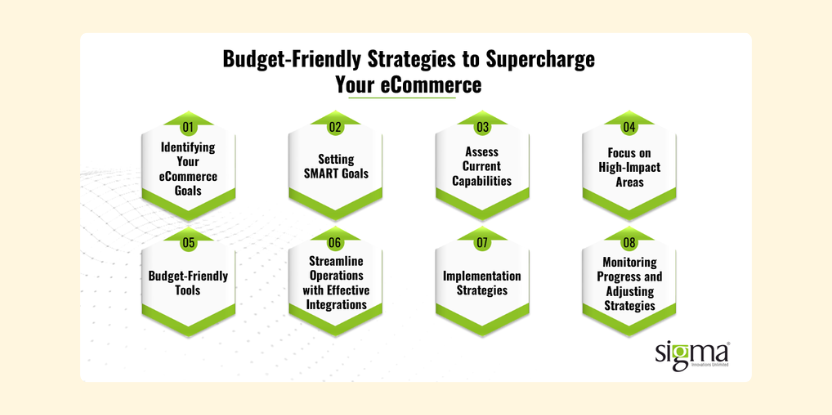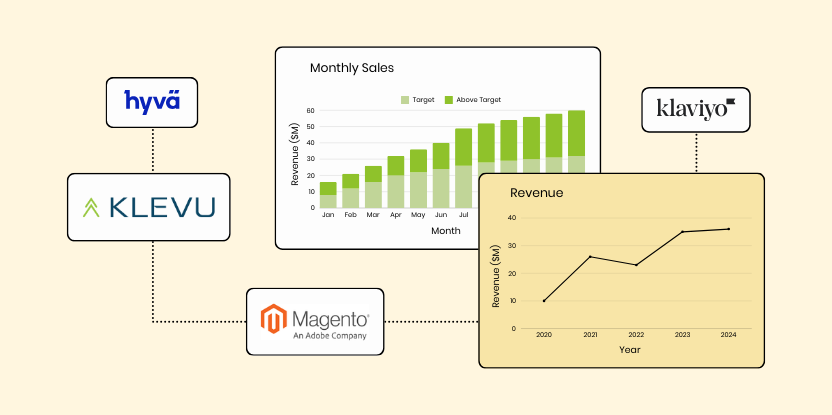
Blog
Budget-Friendly Strategies to Supercharge Your eCommerce
Growing an eCommerce business can feel like a high-wire act. Imagine you run an online store specializing in eco-friendly home goods. You are excited about expanding your product range and attracting more customers, but you are also carefully monitoring every expense to ensure you are not overspending. It’s a challenge many business owners are familiar with.
The great news? You do not have to break the bank to achieve your eCommerce goals. By making smart, targeted decisions—like improving the mobile shopping experience or using budget-friendly marketing tools—you can drive significant growth without a hefty price tag. Let’s walk through some practical steps to help you make the right choices for your business.

Identifying Your eCommerce Goals
Setting goals for your eCommerce business is crucial, and it’s important to distinguish between short-term and long-term objectives. For instance, with the holiday season approaching, your immediate focus might be boosting holiday sales with targeted promotions or streamlining the checkout process to reduce cart abandonment.
Meanwhile, long-term goals could involve expanding your product line or entering new international markets. Recognizing these different timelines helps in making informed decisions.
Here are a few goals you might relate to:
- Increasing Sales: Maybe you want to grow revenue by 20% over the next quarter. This could mean launching a new product line or fine-tuning your site for better conversions.
- Improving Customer Retention: Perhaps you are aiming to encourage repeat purchases. This might involve enhancing your loyalty program or personalizing the shopping experience.
- Expanding to New Markets: If you have found success locally and are ready to go global, you might need to localize your website or expand your shipping options.
Setting SMART Goals
To make your goals actionable, use SMART goals. For example, instead of saying, ‘We want to increase sales,’ try setting a goal like, ‘We want to boost online sales by 20% in the next three months by launching a holiday-themed product line and offering a 10% discount to first-time buyers.
Using a SMART goal helps keep your eCommerce approach clear and actionable, balancing ambition with practicality.
Assess Current Capabilities
Before diving into new solutions, take a moment to evaluate your eCommerce platform’s current performance. What’s working smoothly, and where are the hiccups? Perhaps your site looks great but has slow load times, or your checkout process could be more seamless. Identifying these areas helps you decide what to tackle next.
Focus on High-Impact Areas
After assessing your setup, focus on areas that can make a significant impact. Improving the user experience can greatly affect how customers interact with your site. A smoother, faster, and more intuitive shopping experience often leads to better conversion rates. Site speed is crucial—if your pages are slow to load, customers might leave. And with more people shopping on their phones, making sure your site is mobile-friendly is essential.
Budget-Friendly Tools
You don’t have to spend a fortune to enhance your eCommerce platform. Many affordable tools and extensions can improve your site without stretching your budget. If site speed is an issue, consider caching plugins or image optimization tools. To improve user experience, look for extensions that simplify navigation or make the checkout process smoother. Many of these tools are effective and reasonably priced, making them smart choices for budget-conscious businesses.
Future goals and results
After assessing your setup, focus on areas that can make a significant impact. Improving the user experience can greatly affect how customers interact with your site. A smoother, faster, and more intuitive shopping experience often leads to better conversion rates. Site speed is crucial—if your pages are slow to load, customers might leave. And with more people shopping on their phones, making sure your site is mobile-friendly is essential.
Streamline Operations with Effective Integrations
Harnesses the Power of the Right eCommerce Tools
In the competitive world of eCommerce, the tools you choose can make all the difference. By strategically integrating platforms like Adobe Commerce (Magento), Hyvä, Klevu, and Klaviyo, you can unlock new levels of performance and customer engagement. These powerful solutions offer scalability, customization, and advanced features that can transform your online store—improving everything from site speed and user experience to personalized marketing and intelligent search.
The right integrations not only streamline your operations but also ensure your business is equipped to grow efficiently and effectively, all while staying within budget.

Optimizing Search and Product Recommendations
One critical area to enhance is your search and product recommendation functionality. Advanced search and recommendation tools can significantly improve user experience and drive conversions. Here’s how:
- Enhanced Search Capabilities: Implement AI-driven search tools like Klevu to deliver more relevant search results. Klevu’s advanced search features, such as typo tolerance, natural language processing, and contextual search, can understand user intent better and offer real-time suggestions. This makes it easier for customers to find what they are looking for, even if they make minor spelling mistakes or use complex search queries.
- Personalized Recommendations: Utilize product recommendation engines to suggest items based on user behavior and preferences. With Klevu’s AI-powered recommendation engine, you can offer personalized recommendations, related product suggestions, and dynamic merchandising. These features can increase average order value and encourage repeat purchases by presenting customers with products they are more likely to be interested in.
- Choosing the Right Integrations: Integrations are key to optimizing your eCommerce operations and enhancing the customer experience. Look for solutions that offer scalability, reliability, and fit your budget. Klevu’s integration with various eCommerce platforms ensures seamless enhancement of your search and recommendation functionalities without compromising on performance or increasing costs.
- Utilizing Direct Integration Links: Direct integration links simplify connecting different tools within your eCommerce platform. These often come with pre-built connectors, reducing setup time and minimizing the need for extensive custom development. Using these links helps streamline operations, cut costs, and maintain a more cohesive system.
Implementation Strategies
When implementing new solutions, you will need to decide whether to handle it yourself or bring in experts. If you and your team have the skills, doing it yourself might seem like a cost-effective choice. However, consider the potential downsides. Managing everything in-house can be time-consuming and there’s always the risk of making costly mistakes.
Alternatively, hiring professionals might be more expensive initially but often results in a smoother, more efficient setup. Experts bring specialized knowledge that can help you avoid costly errors and get things right the first time.
Another approach is phased implementation. Instead of rolling out all new features at once, introduce them in stages. This approach helps manage costs and allows you to make adjustments along the way, reducing the risk of overwhelming your budget.
Testing and iteration are also key. Before fully launching a new feature, test it thoroughly. See how it performs and gather customer feedback. This iterative process helps you fine-tune and ensures that each new addition genuinely enhances the user experience. By staying flexible and open to adjustments, you’ll avoid potential pitfalls and ensure your updates are beneficial.
Monitoring Progress and Adjusting Strategies
After implementing new solutions, regularly track your progress. Monitoring key performance indicators (KPIs) like conversion rates, customer retention, and average order value provides insight into how well your strategies are working. Regular reviews help identify areas for improvement and celebrate successes.
Flexibility is crucial in adapting to market changes. The eCommerce landscape evolves quickly, and what worked six months ago might not be effective today. Stay informed about industry trends and be ready to adjust your strategies as needed. By remaining agile, you can continue to grow your business without overspending.
In a nutshell, boosting your eCommerce business on a budget is definitely within reach if you approach it with a smart strategy and a clear plan. Start by setting clear, actionable goals and focusing on the improvements that will have the biggest impact. Make the most of affordable tools and effective integrations to streamline your operations. Implement new features thoughtfully, testing and iterating as you go to ensure they truly enhance your customer experience.
Remember, you don’t need a huge budget to make significant strides. By being strategic with your investments and adaptable in your approach, you can achieve impressive growth while keeping your expenses in check. So, take a moment to review your current strategies, explore budget-friendly options, and stay flexible to navigate the ever-evolving eCommerce landscape.
Sigma Infosolutions, a leading technology services company, can help you with all your eCommerce needs, from development and maintenance to migration and re-platforming. As a trusted partner of Adobe Commerce (Magento), Shopify, and BigCommerce, they offer comprehensive services tailored to your unique business needs. The Sigma team of experienced professionals can help you design, develop, and implement a future-proof eCommerce solution that scales with your business and keeps you ahead of the competition.


